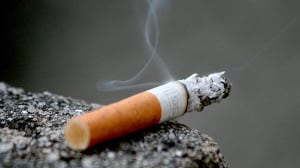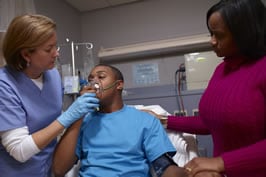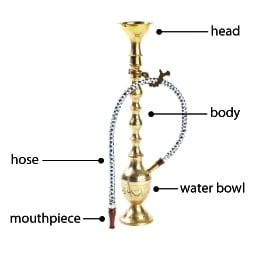
A screen shot of Drake smoking hookah on the single “Girls Love Beyoncé.” Hookah use has nearly doubled overall among students in high school and middle school. It remains popular in college.
Efforts to cut back on smoking need to extend beyond cigarettes to all tobacco products, which are spiking in use among young people, experts say.
A new report indicates that the use of e-cigarettes has tripled while hookah smoking has nearly doubled among middle and high school students.
 E-cigarette use rose from 4.5 percent in 2013 to 13.4 percent in 2014, according to the 2014 National Youth Tobacco Survey. That’s an increase of about 660,000 to 2 million students who said they had used an e-cigarette at least one day in the previous 30 days.
E-cigarette use rose from 4.5 percent in 2013 to 13.4 percent in 2014, according to the 2014 National Youth Tobacco Survey. That’s an increase of about 660,000 to 2 million students who said they had used an e-cigarette at least one day in the previous 30 days.
About 770,000 students said they smoked using a hookah in 2014 compared to 1.3 million in 2014, an increase of 5.2 percent to 9.4 percent. A hookah is a waterless pipe for smoking flavored tobacco.
“We want parents to know that nicotine is dangerous for kids at any age, whether it’s an e-cigarette, hookah, cigarette or cigar,” said Tom Frieden, M.D., M.P.H., director of the Centers for Disease Control and Prevention, which published the data along with the U.S. Food and Drug Administration’s Center for Tobacco Products (CTP) in its current Morbidity and Mortality Weekly Report.
“Adolescence is a critical time for brain development,” Dr. Frieden said. “Nicotine exposure at a young age may cause lasting harm to brain development, promote addiction and lead to sustained tobacco use.”
Some of these habits start early and persist through college — where hookah use is especially popular — and beyond. Previous studies have found a high prevalence of hookah use among U.S. college students ranging from 22 percent to 40 percent.
Among middle school students, e-cigarette also tripled from 120,000 to 450,000 students, or 1.1 percent to 3.9. Their hookah use more than doubled from 120,000 to 280,000 students, or 1.1 percent to 2.5 percent.
Cigars were the most commonly used product among non-Hispanic black high school students at 8.8 percent. In addition to smoking cigars, some young people replace the tobacco with marijuana. Cigar smoking compared with 5.6 percent for hookahs and e-cigarettes, 4.5 percent for regular cigarettes and 1.1 percent for smokeless tobacco.
However, e-cigarettes were most popular among black middle-schoolers at 3.8 percent, followed by 2 percent for cigars and 1.7 percent for regular cigarettes. Hookah use was not statistically significant.
“In today’s rapidly evolving tobacco marketplace, the surge in youth use of novel products like e-cigarettes forces us to confront the reality that the progress we have made in reducing youth cigarette smoking rates is being threatened,” said Mitch Zeller, J.D., director of the FDA’s Center for Tobacco Products. “These staggering increases in such a short time underscore why FDA intends to regulate these additional products to protect public health.”
Hooked on Hookahs
Hookah use dates back to ancient Persia and India. It’s immensely popular today, but hookah smoking can lead to the same cancer risks as cigarette smoking as well as clogged arteries and heart disease. Here are other fast facts about hookah from the Centers for Disease Control (CDC):
- Hookahs are water pipes that are used to smoke specially made tobacco that comes in different flavors, such as apple, mint, cherry, chocolate, coconut, licorice, cappuccino and watermelon.
- Although many users think it is less harmful, hookah smoking has many of the same health risks as cigarette smoking.
- Hookah smoking is typically done in groups, with the same mouthpiece passed from person to person.
- Previous studies have found a high prevalence of hookah use among U.S. college students ranging from 22 percent to 40 percent.
- The amount of smoke inhaled during a typical hookah session is about 90,000 milliliters (ml), compared with 500–600 ml inhaled when smoking a cigarette.
- Tobacco juices from hookahs irritate the mouth and increase the risk of developing oral cancers. Plus, sharing the pipe can lead to other infections.
- Babies born to hookah smokers are also at increased risk for respiratory diseases and low birth weights.
- Even non-tobacco products used in hookahs contain carbon monoxide and other toxic agents that can cause cancer.
Smoke Signals: 5 Quick Tips on Talking to Your Teen About Tobacco
 Parents can make a big difference in whether their teens will use tobacco products — or stronger substances. Here are a few tips from the U.S. Office of Adolescent Health on talking to your teenager and other young people about tobacco.
Parents can make a big difference in whether their teens will use tobacco products — or stronger substances. Here are a few tips from the U.S. Office of Adolescent Health on talking to your teenager and other young people about tobacco.
- Recognize peer influence. When a teen’s friends smoke or approve of smoking, it’s much more likely that he or she will smoke, too. On the other hand, being with positive peers who don’t smoke can be key to teens not starting to smoke or use other forms of tobacco. If your teen’s friends use tobacco, talk to your teen about it and determine together what to do to avoid being negatively influenced.
-

“We want parents to know that nicotine is dangerous for kids at any age,” says CDC director Tom Frieden, M.D., M.P.H. (CDC Photo)
Address your own tobacco use. Not only do teens whose parents smoke face the health risks of second-hand smoke, but also they are more likely to start smoking or using tobacco themselves. Quitting smoking is the best health option for you and your teen. If you cannot or will not quit, consider the following:
- Be direct. Explain why you don’t want your teen to start smoking. If you’ve tried to quit, make sure your teen knows how difficult it is.
- Don’t allow smoking by anyone inside your home, including yourself. Even a partial ban relays negative attitudes toward smoking.
- Watch your stash. Many teen smokers take cigarettes from their parents’ packs. Make sure to keep your cigarettes where your teen can’t easily get them.
- Eat family meals together regularly. Researchers consistently find that teens who eat meals at least five times a week with their family are less likely to smoke or use other drugs. Why? Meals give a chance for families to talk together and for parents to learn more about what’s happening. Most important, though, the meal is part of having a warm, caring and cohesive family.
- Get them involved in positive activities. Teens who are involved in sports, volunteering, cultural activities, youth and after-school programs or religious activities are less likely to use tobacco. Part of this influence comes from being with positive adult and peer role models. Part of it comes from the values, social skills and priorities that they develop through these opportunities.
- Work to reduce acceptance of tobacco use in the community. The messages adolescents get from their community can either reinforce or undermine what they learn at home and at school. Of particular concern is if your neighborhood has a lot of unsupervised places and opportunities for teens. Teens are heavily influenced to use tobacco if they spend a lot of time in neighborhoods where other teens or adults use tobacco.









